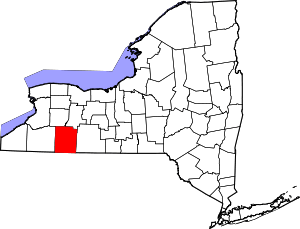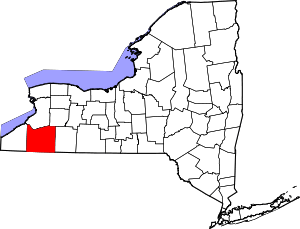Oil Springs Reservation
| Oil Springs Reservation | |
|---|---|
| Indian Reservation | |
 Oil Springs Reservation Location of Oil Springs Reservation in New York | |
| Coordinates: 42°13′56″N 78°18′20″W / 42.23222°N 78.30556°WCoordinates: 42°13′56″N 78°18′20″W / 42.23222°N 78.30556°W | |
| Population (2010 census)[1] | |
| • Total | 1 |
| Website | http://www.sni.org/oilsprings.html |
Oil Springs Reservation or Oil Spring Reservation is an Indian reservation of the Seneca tribe located in New York, United States. As of the 2010 census, the Indian reservation has one resident. Although the reservation is controlled by the Seneca tribe, as of 2005 no tribal members lived on the property. It is about 1.0 mi² (1.6 km²), divided between two present-day counties: Allegany and Cattaraugus. The reservation is northwest of the village of Cuba. It is bordered by the Town of Cuba and the Town of Ischua.
The Seneca and earlier indigenous peoples had learned to use the petroleum-tainted water of the spring for medicinal purposes. Jesuit missionaries learned about it from the Seneca and recorded it as early as the 17th century. Today the Seneca operate two tax-free gas stations on this reservation to generate revenue.
History
When the French Jesuit missionary Joseph de La Roche Daillon reached this area in 1627, the Oil Springs were held by the now defunct Wenro tribe. The Seneca are believed to have conquered the territory in 1638 as one of their first conquests of the Beaver Wars, by which they were trying to dominate the lucrative fur trade with the French.
The Seneca sided with the British Crown in most wars during the 18th century, including the American Revolutionary War, in which the Seneca conducted several massacres against colonial settlements. After the Crown's defeat, the Seneca as allies of the British were required to surrender most of their land (much of which had been ravaged by the Sullivan Expedition). In the Treaty of Canandaigua, the Senecas negotiated the right to keep five plots: the former Wenro territory around Oil Springs and the Allegheny River, the land surrounding Cattaraugus Creek, the former Neutral lands around Buffalo Creek, and the Tonawanda Reservation. (Seneca diplomat Cornplanter later acquired an additional 1500-acre plot in Pennsylvania for his own personal purposes.)
During the federal Indian Removal program of the 1830s, the Ogden Land Company negotiated the right to buy all of the remaining Seneca lands in New York. They convinced the Seneca chiefs to sign the Treaty of Buffalo Creek to that effect. In the end, Ogden purchased only the Buffalo Creek Reservation and left Oil Springs (along with the Allegany and Cattaraugus reservations) intact.
The Seneca Nation of Indians formed as a federally recognized tribe in 1848, counting the Oil Springs Reservation as one of its three territories (along with the Allegany and Cattaraugus). It is the only one of the three Seneca territories without a recognized capital or any representation in Seneca government.
In the 1850s, the Senecas began a case to evict squatters (including Philonus Pattison, Benjamin Chamberlain, Stanley Clark, William Gallagher, and future New York governor Horatio Seymour) and restore Oil Springs to the tribe. Thanks to the efforts of the influential Seneca leader Governor Blacksnake, the reservation was returned to the Senecas in 1861.[2] Blacksnake, who had attended the negotiations of the Treaty of Big Tree, testified that he and Joseph Ellicott had surveyed the Oil Spring lands and the omission of the lands from the treaty was a mistake. He was able to produce a map copied by the Holland Land Company in which the Oil Spring reservation was marked similar to other lands as Seneca.[3]
The U.S. Census of 1890 lists the name of the reservation as Oil Spring Reservation. It is unclear when the reservation's name was changed to Oil Springs.[4]
Geography
According to the United States Census Bureau, the Allegany County portion of the Indian reservation has a total area of 0.6 mi² (1.6 km²). Most of it is land while 1.64% is water.[5]
The Cattaraugus County portion of the Indian reservation, located in the Town of Ischua has a total area of 0.4 mi² (1.0 km²), all land.[5]
Demographics
As of the census[1] of 2010, there are no residents in the Town of Ischua area of the reservation. The single resident on the reservation is Native American and lives in the Allegany County portion of the property.
References
- ↑ 1.0 1.1 "American FactFinder". United States Census Bureau. Retrieved 2008-01-31.
- ↑ Hauptman, Laurence (2008). Seven Generations of Iroquois Leadership: The Six Nations Since 1800. Syracuse University Press. ISBN 978-0-8156-3165-1.
- ↑ Hauptman, Laurence (2008). Seven Generations of Iroquois Leadership: The Six Nations Since 1800. Syracuse University Press. ISBN 978-0-8156-3165-1.
- ↑ Extra Census Bulletin of the Eleventh Census (1890) of the United States (Washington, D.C.:U.S. Printing Office, 1892) (PDF). p. 28. Retrieved 24 April 2015.
- ↑ 5.0 5.1 "US Gazetteer files: 2010, 2000, and 1990". United States Census Bureau. 2011-02-12. Retrieved 2011-04-23.
External links
| |||||||||||||||||||||||||||||||||
| |||||||||||||||||||||||||||||||||||||

